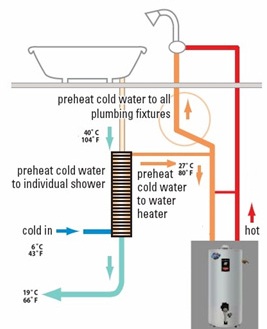aberson
New Member
Hi Everyone
I'm new to the forum, but it looks like a really great resource. I'm hoping to get some feedback on several questions about our tankless heater - repair/supplement/replace. Thanks in advance!
We just bought a 2 bathroom apartment with a natural gas tankless heater. Long story short, we have found out that the unit is only spec'd to provide 2.5GPM for 60* rise, which isn't adequate for 2 simultaneous showers. I can't understand why such a small unit would have been installed here. What size/flow-rate unit is appropriate for a 2 bathroom apartment?
If I restrict the adjustable shower heads so they are totaling about 3GPM of 105* water, then we can take 2 quite weak showers, but at least at a good temp. A plumber came out and told us that our heater was installed without the recommended flow restrictor/selector of 2.5GPM on the inlet, and that's the only tweak that might help our situation a bit. If we install that, I presume it will have similar effect to my restricting the shower heads - a drop in flow, but maintaining temp. Is this right?
Is there a way to supplement the existing heater without replacing it? For example, a small electric unit after the heater and before the mixing valve, to add a few degrees if the temp from the main heater drops too low (because the flow rate is too fast for adequate heat exchange in the main unit's coil).
We have some money in escrow from the seller to repair this, but I don't think it would cover the cost of a complete replacement. Can anyone tell me what a 4-5GPM heater would cost to professionally install? From seeing heater costs at home depot, and looking at the amount of work to install, I expect heater plus installation should be $2-3k total, but I see numbers much higher than that, and I'm not sure why. Perhaps after some energy credits and selling the old heater that still has lots of life (is that possible?) we might recover some of our out of pocket cost above our escrow...
Thanks!
Adam
I'm new to the forum, but it looks like a really great resource. I'm hoping to get some feedback on several questions about our tankless heater - repair/supplement/replace. Thanks in advance!
We just bought a 2 bathroom apartment with a natural gas tankless heater. Long story short, we have found out that the unit is only spec'd to provide 2.5GPM for 60* rise, which isn't adequate for 2 simultaneous showers. I can't understand why such a small unit would have been installed here. What size/flow-rate unit is appropriate for a 2 bathroom apartment?
If I restrict the adjustable shower heads so they are totaling about 3GPM of 105* water, then we can take 2 quite weak showers, but at least at a good temp. A plumber came out and told us that our heater was installed without the recommended flow restrictor/selector of 2.5GPM on the inlet, and that's the only tweak that might help our situation a bit. If we install that, I presume it will have similar effect to my restricting the shower heads - a drop in flow, but maintaining temp. Is this right?
Is there a way to supplement the existing heater without replacing it? For example, a small electric unit after the heater and before the mixing valve, to add a few degrees if the temp from the main heater drops too low (because the flow rate is too fast for adequate heat exchange in the main unit's coil).
We have some money in escrow from the seller to repair this, but I don't think it would cover the cost of a complete replacement. Can anyone tell me what a 4-5GPM heater would cost to professionally install? From seeing heater costs at home depot, and looking at the amount of work to install, I expect heater plus installation should be $2-3k total, but I see numbers much higher than that, and I'm not sure why. Perhaps after some energy credits and selling the old heater that still has lots of life (is that possible?) we might recover some of our out of pocket cost above our escrow...
Thanks!
Adam

